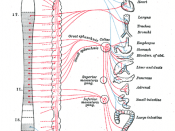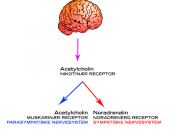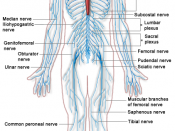The nervous system consists of neurons and axons. Neurons are responsible for receiving and transmitting electrochemical signals. Axons are long fibers of the neuron that carryout efferent nerves (messages). The neuron sends an electrical message from its body by way of the axon. Each neuron has an axon (Pinel, 2008).
The peripheral nervous system (PNS) and the central nervous system (CNS) are similar because they both consist of neurons and axons. The differences lie in the anatomy of the neurons and axons. The CNS has sets of neurons called nuclei (singular nucleus) and bundles of axons are called tracts. The PNS has sets of neurons called ganglia (singular ganglion) and sets of axons called nerves. Another difference is the areas of the systems: The CNS consists of two divisions; the brain and spinal cord. The PNS also has two divisions; the somatic nervous system and the autonomic nervous system, which is found outside the skull and spine (Pinel, 2008).
As stated, the central nervous system consists of the brain and spinal cord. The brain receives its input from the senses of the spinal cord and its own nerves (i.e. olfactory and optic nerves). Its applications are to processing and initiating a proper motor response. The spinal cord sends sensory information to the brain. When message is received, the spinal cord then sends motor information to other parts of the body (i.e. skeletal and cardiac muscles, glands). Within the CNS are the glial cells, they act as insulation for the neurons. There are three types; astrocytes (help pass chemicals from blood to CNS neurons), oligodendrocytes (myelinate axons), and microglia (aid in responding to injury or disease - part of immune system). Myelination is the process of producing myelin sheathes (coverings on axons, which help the effectiveness of the axonal transmission) (Pinel,


